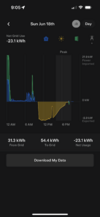Just pulled the trigger with Tesla on 12.4kWh PV w/ 2x PW+ and GW 2.0. I have underground 100amp service in NorCal with PG&E. The cost to trench is prohibitive so leaving original service equipment alone. As one might guess, 100amps is adequate but doesn't leave a lot of headroom.
My question is if playing the TOU arbitrage game and grid charging my PW is there risk of using all my service amps and tripping the main breaker?
My understanding is each PW+ can pull ~32 amps each to recharge. So ~64 amps from the grid worst case scenario. If I fire up my AC, electric oven on top of the PWs etc... does the GW automatically slow down the rate of grid charging? Presumably the equipment is programmed to know I only have 100amp service?
Thanks in advance! I hadn't originally contemplated the possibility of the PW being a major draw from the grid, but with Storm Watch and time based grid charging seems a possibility they may start drawing heavily from the grid at the most inopportune time.
My question is if playing the TOU arbitrage game and grid charging my PW is there risk of using all my service amps and tripping the main breaker?
My understanding is each PW+ can pull ~32 amps each to recharge. So ~64 amps from the grid worst case scenario. If I fire up my AC, electric oven on top of the PWs etc... does the GW automatically slow down the rate of grid charging? Presumably the equipment is programmed to know I only have 100amp service?
Thanks in advance! I hadn't originally contemplated the possibility of the PW being a major draw from the grid, but with Storm Watch and time based grid charging seems a possibility they may start drawing heavily from the grid at the most inopportune time.



